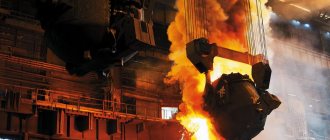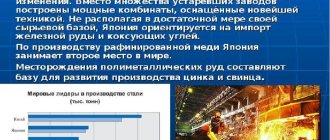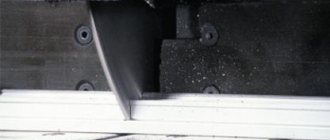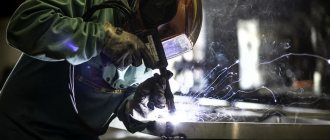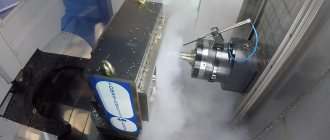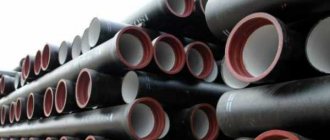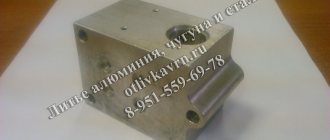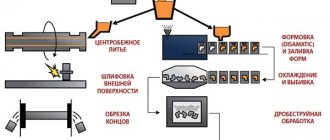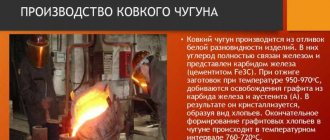Iron casting manufacturing stages and manufacturing process
Years passed and foundry production, iron casting in particular, began to be actively used in the field of art. Cast iron sculptures were smelted en masse, new qualities of the alloy were discovered, which made it possible to play with shades and shadows. Large iron casting is still developing today, creating new forms and incorporating innovative methods.
Iron foundries use different smelting techniques using alloys. Metal in its pure form is rarely found; alloys from:
- aluminum
- bronze
- brass
Alloys are achieved by processing high temperatures and chemical reactions. The technical characteristics of the resulting steel from cast iron depend on what additional materials were used. If forging is necessary, then bronze will be a soft and ductile material if the alloy contains a minimum amount of tin. If the alloy contains a lot of tin, the bronze will become brittle and will break during processing.
Iron casting plant
The Moscow iron foundry uses various technologies to produce high-quality cast iron products. The main ones are earth casting and casting using ready-made lost wax models. The iron foundry process is quite labor-intensive and painstaking; it is important to correctly complete all stages and follow the sequence.
If a large iron casting plant has accepted an order for the production of blanks and elements needed in the engineering field, then the principle of operation is as follows. First, the molten metal is placed in a mold in which a specific workpiece is installed. Next, the metal cools, hardens, and takes on the shape into which it was poured in molten form. As a result, you receive high-quality finished castings that are durable and reliable. A variety of methods can be used to make castings:
- Centrifugal casting
- Lost wax casting
- Sand casting
- Injection molding.
Making iron castings
Cast iron is the starting material necessary for the production of steel in open-hearth furnaces. Previously, the amount of pig iron produced indicated the economic strength of a country. In Moscow, it carries out foundry production in a high-quality and professional manner - iron casting. Specialists with decent work experience can smelt any composition of varying degrees of complexity in several stages. The main ones:
- Preparatory (a sketch and model of the future product is being developed)
- Creating a mold for metal casting
- Melting cast iron ingots
- Casting melts into pre-prepared molds
- Removal of castings and their further finishing.
There are several common technologies for making models and preparing molds. Among them are the main methods of iron casting:
- Earth casting - this method involves casting metal into clay-sand molds. A model of the future finished structure is lowered inside the form, which completely repeats its shape. Only the model should be slightly larger in size than the size of the casting shrinkage. The clay-sand solution is compacted and compacted, completely adhering to the model.
- IMPORTANT TO KNOW: cast iron is placed into the mold through specially equipped holes called sprues.
- In plaster molds - made from other hardening impurities.
- In shell forms
- Chill casting - this method involves casting into reliable metal molds
- By smelted billets
- Injection molding
- Casting using gasified models.
The Moscow Foundry produces iron castings in blast furnaces. After the alloy is melted and impurities are removed, the cast iron is cast into special molds called molds. The result is ingots containing cast iron, ready for further processing. The finishing line is the production of various finished products from castings.
Basic steel casting processes and technologies
Lost wax casting: technology, advantages and disadvantages
Steel casting is carried out using several technologies. This method of metal processing includes the following processes:
- Melting of the charge.
- Boiling.
- Subsequent deoxidation of non-metallic components.
Fuse
Steel melting can be done at home. To do this you need to have a graphite crucible. Fire-resistant brick is chosen as the base.
The furnace manufacturing procedure is as follows:
- At a short distance from each other, 2 copper busbars are installed, which are bolted to the brick. A metal plate is first laid underneath them, one end of which is bent.
- A transformer is connected to the buses.
- A crucible is placed on a metal plate in which the metal will be melted.
- The curved part of the plate touches the crucible.
The essence of the process is that graphite is a poor conductor of electricity, so when current passes it becomes very hot. Due to this, the melting of the metal occurs.
Melting steel at home
Additional Methods
The following methods of casting parts exist:
- Oxygen converter. Based on the production of castings from cast iron. The process of oxidation of impurities occurs due to the supply of oxygen. The temperature in the chamber is 1600 degrees.
- Martenovsky. It is simple and convenient.
At the end of the process, molten metal is poured into molds. For this, there is a gating system, which consists of channels leading to casting molds.
Steel ingots are produced using a continuous production method. The molten metal enters the crystallizer. There it hardens, and then is taken out and pulled by rollers. In order to quickly cool down, it is watered. At the last stage, it is cut into measured pieces.
Foundries: production of iron castings
It is enough to go to the World Wide Web to see how many foundries have been formed that specialize in casting iron. Enterprises producing iron castings offer their products, luring customers with low prices and short order execution times. However, can you be sure of the quality of the products provided? Not all iron foundries in Russia can guarantee the reliability and durability of their products and provide a quality certificate.
Iron casting plant LLC "Moscow Foundry" has been occupying a leading position among foundries for several years in a row. We produce cast iron according to individual sketches or provided samples. You can show our specialists a photo of the desired product - and after some time you will receive from us a finished composition identical to the one shown in the photo. We accept orders for small cast iron castings: these can be parts for various mechanisms, original figures or figurines that are an excellent interior decoration.
Cast iron products produced at our plant will surprise you with their durability, reliability, and impeccable performance. For cast iron casting, the masters of the Moscow Foundry use several types of metal, which are formed by adding various impurities.
Cast iron at home
I read the forum - I still can’t figure out whether anyone has managed to cast cast iron with satisfactory quality, or at least make a part out of it, and not just melt it.
As I understand it, a jew's harp cannot be small (in sizes no more than 50 liters of a propane cylinder), and it does not produce an acceptable quality of metal (suitable for the manufacture of machine tool parts). (I know about further aging). To improve it, an accumulation furnace is used, where liquid metal accumulates, disassembled, and alloys are introduced. Cutting it down doesn't really work. With this type, the option with a harp is no longer necessary? Is it possible to melt cast iron (up to 5 - 10 kg) in a steel crucible from a scrap cylinder, for example on gas burners or coal? If high-quality cast iron scrap is used (for example, pieces of a broken frame from a Soviet machine tool) and melting takes place in a crucible, does this ensure the quality of the extracted product at the output (the mode of heat treatment, casting, cooling and aging is special), at least in a chemical sense - does it burn out? and carbon and alloys? It’s absolutely possible to melt cast iron at home, it’s just that no one needs it separately yet. A cupola furnace cannot be small, it’s true, the network will not support an electric furnace; all that remains is a fiery furnace and melting either in a crucible or on a hearth. In a crucible, the change in cast iron composition will be smaller. You can sculpt crucibles yourself from graphite and fireclay chips, although they are short-lived but cheaper. Read ancient books on smelting, then everything is clearly described, including images of furnaces and smelting modes. Now I’m also curious about this process, I’m starting to gradually go through it.
The correct coating has the appearance of varnish, is hard and does not get wet in water. My experimental frying pan has been in use for six months now, but I deliberately wash it with weak soap and do not lubricate it with oil. I just wipe it and heat it on the burner (the last procedure also allows you to get rid of the smells of the last dish). During this time, the coating on the bottom has been scratched, so in the very near future I will fly it from below, and for now I will use the top as before.
And also, before welding the part, you need to determine the grade of cast iron, at least approximately, in order to more accurately determine the welding method. There are varieties. Cast iron is marked as L1 L2 and so on up to L6, but there are other markings. Here are all the markings I'm familiar with. L1 L2 L3 L4 L5 L6 LR1 LR2 LR3 LR4 LR5 LR6 LR7. LR means cast iron refined with magnesium.
Have a nice day, forum members. I read here about melting cast iron and casting it into blanks or ingots. What about the real details? Please do not send to YouTube. I then noticed a video about “lost wax casting”, but then the factory. , but I’m interested in it being free and angry. I pour colored metal into plaster with sand. But I think at such a high temperature the plaster seems to be destroyed. what to replace it with?
Cast iron is made from an alloy of iron, carbon, silicon and phosphorus. At a temperature of 1400 degrees, the cast iron product is cast using seamless technology in a whole earthen figure, which splits after casting the product. At the end of production, the product is cleaned, minor imperfections that occur during the casting of a cast iron figure are removed to obtain a perfectly clean, rough surface. Several layers of enamel are applied to the outer and inner side of the product, after which the cast iron product is fired at a temperature of 800 degrees for half an hour. Sharp porous enamel allows drops of fat to easily penetrate the small pores of cast iron and create a non-stick coating. This enamel provides the most global heat distribution and uniform cooking of food. The last stage of the industrial cycle is the installation of accessories.
Unambiguously! For multi-storey buildings with central heating, it is recommended to install cast iron radiators. They are not subject to corrosion and retain heat well. Their primary advantage over other radiators is that they do not react to the quality of the coolant. Heating water undergoes water treatment and various reagents are added significantly. Starting from salt and soda, and various additives to soften water. All current radiators react strongly to the lack of water in the system. According to the instructions, it is not recommended to drain water from the system for more than 15 days. And here we drain it for the whole summer season. So there you go! In aluminum, bimetallic and metal radiators, the process of decomposition of the remaining water occurs. This causes wear and tear on the radiators. Cast iron radiators solve all this. They don't react with anything. Therefore, their durability is 50 years or more. Cast iron radiators are immediately available in the current design. Radiators are supplied coated with baked epoxy polyester enamel. They don't feel the need to paint. For example, radiators from KONNER: MODERN, HIT, Retro, etc. The photo shows a MODERN radiator.
Before the main use of cast iron cookware, it is recommended to wash it with hot water and soap, then wipe it dry, and then lubricate the entire surface of the cookware with fat or vegetable oil. After this, bake in the oven for one hour. Current professional cast iron cookware does not require old-fashioned processing; it is already completely ready for use, since it has an internal enamel coating.
Types of cast iron
Gray cast iron containing graphite and silicon has excellent casting properties (low melting temperature, high melt fluidity and minimal shrinkage). This type of metal is used for machine bodies and various mechanisms. Gray cast iron products for cars are ideal as parts for pistons. Also used for engine blocks and cylinders in cars.
VChShG cast iron is a reliable material containing graphite in a spherical form. This type of graphite has its own characteristics: high viscosity and malleability. This cast iron is used for the manufacture of pipelines.
Products made from high-strength cast iron are made by casting into a gasified mold. The workshop produces high-quality cast iron, and to improve the mechanical properties of the metal, the castings are processed at high temperatures. Heat treatment of ductile iron guarantees high quality technical cast iron. Using heat treatment, it is possible to achieve uniformity of the metal, and this process also reduces the risk of cracks during product operation.
Cast iron alloys used and cost of castings
- Gray cast iron GOST 1412-85: SCh10, SCh15, SCh20, SCh25, SCh30, SCh35 from 102 rubles/kg;
- High-strength cast iron according to GOST 7293-85: VC40, VC45, VC50, VC60 from 135 RUR/kg;
- Special types of cast iron, alloyed cast iron according to GOST 7769-82: ChH1, ChH16M2, ChH16 from 170 RUR/kg, ChH28N2, ChH28 from 360 RUR/kg, ChH32 from 380 RUR/kg, ChS5 from 125 RUR/kg, ChS5Sh, etc.;
- Anti-friction cast iron according to GOST 1585-85: AChS-1, AChS-3, AChS-5 from 142 rubles/kg, etc.
- It is possible to cast cast iron from the customer’s choice of grades
*** Prices are indicated for 1 kg of castings including VAT
Iron casting production
"Moscow Foundry" accepts orders for the production of cast iron in small and large volumes. Metal is produced using blast furnaces; the iron casting shop has all the necessary modern equipment for the manufacture of parts for various mechanisms and engines. The products are durable and highly durable. Cast iron production does not stand still, technologies are constantly being improved, specialists are working on new techniques and methods. The development of innovative methods is aimed at increasing energy efficiency, increasing environmental friendliness, and reducing metal consumption.
Among the unique properties of cast iron are minimal price, reliability and corrosion resistance. The production of heavy iron casting has not lost its popularity, so it is confidently in demand.
Cast iron castings differ:
- to size
- according to manufacturing configuration.
These can be small parts needed for car engines or large items required for large-scale machine tools.
The shape of the castings is also varied. From standard bushings to original cast grilles and decorative gates
Methods
Casting cast iron into cold-hardening mixtures is one of the modern technologies. This solution assumes that the molds are made from a mixture that includes binding elements, such as resins. The advantage of a mold made from such a mixture is increased tightness. Thanks to this, the possibility that the integrity of the product structure will be compromised during production is excluded.
Sand casting is also popular. This technology uses sand that has been compacted. This method is suitable for mass production of large parts, such as turbine blades or large parts of other machinery.
Currently, iron casting is undergoing active development. New production methods are being successfully introduced into the technological field.
Iron casting manufacturers
Before you start searching for iron casting manufacturers, you can monitor enterprises in order to identify the best contenders. There are different iron casting plants, however, the best of them is the Moscow Foundry, famous for its conservative prices, the availability of modern equipment necessary for casting iron, as well as highly professional craftsmen.
The methods used for casting cast iron at the plant are different. The most common is casting using gasified models. This method makes it possible not only to implement cast iron, but also to obtain steel castings in the process of iron casting. Using this method, we can talk about rational consumption of metal and high environmental friendliness.
Ordering iron casting from the Moscow Foundry has many advantages:
- favorable pricing policy
- reliability, strength and wear resistance of products
- ideal surface quality that requires minimal further machining.
It is worth noting that with the use of modern casting methods, not only the casting is profitable, but the finished products also have a low cost. And as a result, it can offer customers the minimum price for the production of cast iron.
"Moscow Foundry" accepts orders for the production of iron castings according to your drawings, sketches or samples. We are ready to take on any order, regardless of its complexity and tight deadlines. The company produces a wide range of products from cast iron and steel of various shapes and configurations. The plant has many years of experience, and artistic and heavy iron casting has been a priority area of our activity for several years.
If you have a country house or cottage complex, then you can use cast iron products as decorative elements. Such works can exquisitely highlight the interior of the house and always look stylish and original.
Artistic cast iron can serve you for decades, while figurines and figurines made of cast iron do not require special care. These can be antique busts that can be installed on the private property adjacent to the house, as well as a variety of garden and park sculptures, three-dimensional figures of animals. It is also possible to produce sculptural compositions consisting of several figures. With the help of such products you can decorate your desktop or office. For these purposes, chic floor or tabletop works of art - cast iron masterpieces - are ideal.
History and essence of technology
The history of human work with metal begins in the 4th millennium BC. This is evidenced by various archaeological finds. However, the quality and precision of the work began to appear in the 2nd millennium. Archaeological finds from this time period indicate that the origins of craftsmanship manifested themselves then. From this moment on, metalworking becomes not only a craft, but also a decorative and applied art.
The essence of the technology for making sculptures from cast iron is that a hollow form is initially created into which molten metal is poured. When hardened, it follows all the lines, edges and details that are outlined in the hollow form. When the metal hardens, it is released from the mold. Today, one of the most famous areas of working with cast iron is Kasli casting.
- An original sculpture is made from plastic materials.
- A casting mold is created using the finished sculpture.
- The metal is melted and poured into the finished template.
- After the metal hardens, the outer frame is removed from it. The surface is cleaned.
The most difficult thing to produce is castings with voids inside.
Casting orders
We will be happy to accept orders for the production of:
- sewer cast iron hatches
- storm water inlets necessary for laying a storm sewer system
- artistic products (fences, gratings, benches, benches, various decorative fences, original lighting designs)
- wear-resistant parts necessary for construction equipment - teeth of tractor buckets, loaders, blades of various sizes and shapes, etc.)
- cast iron bushings
- cast iron blanks of various sizes and diameters.
The Moscow Foundry produces iron castings according to individual designs. If you don’t have your own developments of what the future model should look like, then you can select the necessary parts and products from the product catalog presented on our website.
The company’s specialists carry out the manufacturing process independently from start to finish: from the development of a model and drawing to the final stage of processing the castings. To monitor technological production and ensure the highest quality of products, the Moscow Foundry has its own laboratories, which are equipped with a set of testing and measuring instruments that make it possible to diagnose the chemical composition of the metal and the characteristics of the casting.
Modern methods and worthy experience of the professional team of our plant ensure prompt execution of orders. At the same time, the quality of finished products is always at the highest level.
Not Found
Gray cast iron is a technologically advanced material, has good fluidity, and a low tendency to form shrinkage defects compared to other types of cast iron. It can be used to produce castings of the most complex configurations with wall thicknesses from 2 to 500 mm. The standardization of gray cast iron (GC) is based on the principles of regulating the minimum permissible value of tensile strength. The grades and mechanical properties of gray cast iron according to GOST 1412-85, ISO 185 and national standards of some countries are given in Table. 58 - 60. According to GOST 1412-85 grade of gray cast iron
determined by the tensile strength of cast iron.
The symbol of the brand includes the letters SCh - gray cast iron and a digital designation of the value of the minimum tensile strength in MPa x 10-1: SCh 20 GOST 1412-85.
The mechanical properties of gray cast iron are ensured in the cast state or after heat treatment. Since the strength values of cast iron of a given grade in a casting depend on the cooling rate determined by the wall thickness (diameter) of the casting, the standards provide the minimum values of σв in separately cast test pieces of other diameters or sections from the middle part of each grade (Table 59). Classification of gray cast iron according to the international standard ISO 185
includes six classes, established on the basis of the results of mechanical tensile tests of samples cut from various casting samples.
A characteristic indicator that determines the grade of cast iron is the tensile strength of std samples from separately cast cylindrical samples with a diameter of 30 mm. According to the German standard DIN 1691,
the order for castings must clearly indicate: is the characteristic property tensile strength or Brinell hardness? Depending on this, the marking of cast iron is indicated differently. For example:
Cast iron DIN 1691-GG-25
or
Cast iron DIN 1691-GG-210 HB
Data on tensile strength given in table. 59, are guaranteed in castings. The relationship between wall thickness (2.5-80 mm) and the hardness of castings from various grades of castings is presented in DIN 1691 in a regulated form (Table 59c), which allows you to correctly and accurately set the hardness for a given range of wall thicknesses of castings.
58. Domestic grades of gray cast iron and foreign analogues
| Russia, GOST 1412-85 | ISO 185 | UK, BS 1452 | Germany, DIN 1691 | USA, ASTM A 48 | Japan, JIS G 5501 |
| SCH 10 | 100 | 100 | GO-10 | 20 V | FC 100 |
| SCH 15 | 150 | 150 | GG-15 | 25 V | FC 150 |
| SCH 18 | — | 180 | — | — | — |
| SCH 20 | 200 | 200 | GG-20 | CALL | FC 200 |
| SCH 21 | — | 220 | — | — | — |
| SCH 24 | — | — | — | — | — |
| SCH 25 | 250 | 250 | GG-25 | 35 V | FC250 |
| — | — | — | — | 40 V | — |
| SCH 30 | 300 | 300 | GG-30 | 45 V | FC 300 |
| SCh 35 | 350 | 350 | GO-35 | 50 V | FC 350 |
59. Mechanical properties of domestic and foreign gray cast irons
| Standard | Cast iron grade | Wall thickness, mm | Temporary tensile strength, MPa, not less | Hardness HB |
| GOST 1412-85 | SCH 10 | 4 8 15 30 50 80 150 | 140 120 100 80 75 70 65 | 205 200 190 185 156 149 120 |
| ISO 185 | 100 | 2,5 — 10 10 — 20 | 120 90 | — — |
| BS 1452 | 100 | 30 | 100 | — |
| DIN 1691 | GG-10 | 5 — 40 | 100 | — |
| ASTM A 48 | 20V | 30,5 | 138 | — |
| JIS G 5501 | FC 100 | 4 — 50 | 98,1 | 201 |
| GOST 1412-85 | SCH 15 | 4 8 15 30 50 80 150 | 220 180 150 110 105 90 80 | 241 224 210 201 163 156 130 |
| ISO 185 | 150 | 2,5 — 10 10 — 20 20 — 30 30 — 50 | 155 130 115 105 | — — — — |
| ISO 185 | 150 | 20 — 40 40 — 80 80 — 150 150 — 300 | 120 * 110 * 100 * 90 ** | — — — — |
| BS 1452 | 150 | 30 | 150 | — |
| DIN 1691 | GG-15 | 2,5 — 5 5 — 10 10 — 20 20 — 40 40 — 80 80 — 150 150 — 300 | 180 155 130 120 110 100 90*** | — — — — — — — |
| ASTM A 48 | 25V | 30,5 | 172 | 205 |
| JIS G 5501 | FC 150 | 4 — 8 8 — 15 15 — 30 30 — 50 | 186 167 147 127 | 241 223 212 201 |
| GOST 1412-85 | SCH 18 | 30 | 180 | — |
| BS 1452 | 180 | 30 | 180 | — |
| GOST 1412-85 | SCH 20 | 4 8 15 30 50 80 150 | 270 220 200 160 140 130 120 | 255 240 230 216 170 163 143 |
| ISO 185 | 200 | 2,5 — 10 10 — 20 20 — 30 30 — 50 | 205 180 160 145 | — — — — |
| ISO 185 | 200 | 20 — 40 40 — 80 80 — 150 150 — 300 | 170* 150* 140** 130** | — — — — |
| BS 1452 | 200 | 30 | 200 | — |
| DIN 1691 | GG-20 | 2,5 — 5 5 — 10 10 — 20 20 — 40 40 — 80 80 — 150 150 — 300 | 200 — 300 205 180 170 150 140 130 *** | — — — — — — — |
| ASTM A 48 | Z0V | 30,5 | 207 | — |
| JIS G 5501 | FC 200 | 4- 8 8 — 15 15 — 30 30 — 50 | 235 216 196 167 | 255 235 223 217 |
| GOST 1412-85 | SCH 21 | 30 | 300 | — |
| BS 1452 | 220 | 30 | 220 | — |
| GOST 1412-85 | SCH 24 | 30 | 240 | — |
| GOST 1412-85 | SCH 25 | 4 8 15 30 50 80 150 | 310 270 250 210 180 165 150 | 260 255 245 238 187 170 156 |
| ISO 185 | 250 | 4 — 10 10 — 20 20 — 30 30 — 50 | 250 225 205 185 | — — — — |
| ISO 185 | 250 | 20 — 40 40 — 80 80 — 150 150 — 300 | 210 * 190 * 170 ** 130 ** | — — — — |
| BS 1452 | 250 | 30 | 250 | — |
| DIN 1691 | GG-25 | 5 — 10 10- 20 20 — 40 40 — 80 80 — 150 150 — 300 | 250 — 350 225 210 190 170 160 *** | — — — — — — |
| ASTM A 48 | 35V | 30,5 | 241 | — |
| ASTM A 48 | 40V | 30,5 | 276 | — |
| JIS G 5501 | FC 250 | 4 — 8 8 — 15 15 — 30 30 — 50 | 275 255 245 216 | 269 248 241 224 |
| GOST 1412-85 | SCH 30 | 4 8 15 30 50 80 150 | — 330 300 260 220 195 180 | — 270 260 250 197 187 163 |
| ISO 185 | 300 | 10 — 20 20 — 30 30 — 50 | 270 245 225 | — — — |
| ISO 185 | 300 | 20 — 40 40 — 80 80 — 150 150 — 300 | 250 * 220 * 210 ** 190 ** | — — — — |
| BS 1452 | 300 | 30 | 300 | 262 |
| DIN 1691 | GG-30 | 10 — 20 20 — 40 40 — 80 80 — 150 150 — 300 | 300 — 400 250 220 210 190 | — — — — — |
| ASTM A 48 | 45V | 30,5 | 310 | — |
| JIS G 5501 | FC 300 | 8 — 15 15 — 30 30 — 50 | 304 294 265 | 269 262 248 |
| GOST 1412-85 | SCh 35 | 4 8 15 30 50 80 150 | — 380 350 310 260 225 205 | — 290 275 270 229 201 179 |
| ISO 185 | 350 | 10 — 20 20 — 30 30 — 50 | 315 290 270 | — — — |
| ISO 185 | 350 | 20 — 40 40 — 80 80 — 150 150 — 300 | 290 * 260 * 230 ** 210 ** | — — — — |
| BS 1452 | 350 | 30 | 350 | — |
| DIN 1691 | GG-35 | 10 — 20 20 — 40 40 — 80 80 — 150 150 — 300 | 350 — 450 290 260 230 210 *** | — — — — — |
| ASTM A 48 | 50V | 30,5 | 345 | — |
| JIS G 5501 | FC 350 | 15 — 30 30 — 50 | 343 314 | 277 269 |
| ASTM A 48 | 55V | 30,5 | 379 | — |
| ASTM A 48 | 60V | 30,5 | 414 | — |
| * Tidal sample with a diameter of 30 mm. ** Tidal sample with a diameter of 50 mm. *** Indicative data. | ||||
59a. Mechanical properties of gray cast iron not provided for by GOST and given in the annexes to some national standards
| Cast iron grade | σben, MPa | σcom, MPa | τav, MPa | KS, kJ/m | E 10-3, MPa | σben-1, MPa | K1s, MPa m1/2 |
| GOST 1412-85 SCh 10 SCh 15 SCh 20 SCh 25 SCh 30 SCh 35 | 280 350 420 490 560 630 | 530 650 800 950 1100 1250 | 110 150 200 250 300 350 | — 10 20 40 60 80 | 70 — 110 70 — 110 85 — 110 90 — 110 125 — 145 130 — 160 | — 70 90 110 140 160 | — 10 15 20 25 25 |
| DIN 1691 GG-15 GG-20 GG-25 GG-30 GG-35 | 250 290 340 390 490 | 600 720 840 960 1080 | 170 230 290 345 400 | — — — — — | 78 — 103 88 — 113 103 — 118 108 — 137 123 — 143 | 70 90 120 140 145 | 10 13 15 18 20 |
| BS 1452 150 180 220 260 300 350 400 | — — — — — — — | 600 672 768 869 960 1080 1200 | 173 207 253 299 345 403 460 | — — — — — — — | 100 109 120 128 135 140 145 | 68 81 99 117 136 145 152 | — — — — — — — |
59b. Hardness classes of gray cast iron according to ISO 185
| Hardness class | Limits of change in hardness of NV | Hardness class | Limits of change in hardness of NV |
| N 145 | 170 max | N 215 | 190 — 240 |
| N 175 | 150 — 200 | N 235 | 210 — 260 |
| N 195 | 170 — 220 | N 255 | 230 — 280 |
In UK standard BS 1452
seven grades of gray cast iron are presented.
The US standard ASTM A 48
includes nine grades of cast iron.
The brand designation includes a numerical designation and the letter “B.” The number determines the tensile strength (psi), for example: 20B ASTM A 48.
Japanese standard JIS G 5501
includes six grades of cast iron.
The symbol of the brand includes the letters FC and a digital designation of the value of the minimum tensile strength in MPa x 10-1, for example: FC 25 JIS G 5501.
The mechanical properties of cast iron, ensuring the durability and reliability of the product, not provided for by GOST and given in the appendix of national standards, are given in table. 59a. In most national standards for gray cast iron, which regulate mechanical properties, the chemical composition of cast iron is not specified, except for the standards of Russia and the USA.
59th century Brinell hardness of gray cast iron castings according to DIN 1691
| Cast iron grade * | Wall thickness, mm | Brinell hardness HB** | |
| minimum | maximum | ||
| GG-150HB | 2,5 — 5 5 — 10 10 — 20 20 — 40 40 — 80 | — — — — — | 210 185 170 160 150 |
| GG-170HB | 2,5 — 5 5 — 10 10 — 20 20 — 40 40 — 80 | 170 140 125 110 100 | 260 225 205 185 170 |
| GG-190HB | 4 — 5 5 — 10 10 — 20 20 — 40 40 — 80 | 190 170 155 135 120 | 275 260 230 210 190 |
| GG-220HB | 5 — 10 10 — 20 20 — 40 40 — 80 | 200 180 160 145 | 275 250 235 220 |
| GG-240HB | 10 — 20 20 — 40 40 — 80 | 200 180 165 | 275 225 240 |
| GG-260HB | 20 — 40 40 — 80 | 200 185 | 275 260 |
| * The grade of cast iron indicates the hardness values corresponding to the casting wall with a thickness of 15 mm, except for GG-260 HB. ** The hardness range is only valid for the specified wall thickness range. The hardness interval can be different, but the difference must be at least 40 HB. | |||
60. Area of application of gray cast iron of the most common grades
| Cast iron grade | Parts requirements | Manufactured parts |
| SCH 30 | Conditional bending stresses up to approximately 50 MPa Conditional pressure between rubbing surfaces 2 2 MPa High tightness | Shear and press beds, blocks and plates of multi-spindle machines, lathe chucks, gears Guide plates, beds with guides for turret, automatic, lathe and other heavily loaded machines; couplings, cams Hydraulic cylinders, housings of hydraulic pumps, compressors and high-pressure spools |
| SCH 25 | Heat resistance and increased strength | Chill molds, exhaust pipes, fittings |
| SCH 20 | Conditional bending stresses up to approximately 30 MPa Conditional pressures between rubbing surfaces > 0.5 MPa (> 0.15 MPa in castings weighing more than 10 tons) or susceptibility to surface hardening High tightness | Slotting machine beds, vertical stands of milling, planing and boring machines Beds with guides of most metal-cutting machines, gears, flywheels, brake drums, clutch discs Hydraulic cylinders, liners, housings of hydraulic pumps, spools and valves of medium pressure (up to 8 MPa) |
| SCH 18 | Medium strength and good machinability | Case parts |
| SCH 15 | Conditional stresses up to approximately 10 MPa Pressure between rubbing surfaces ≤ 0.5 MPa | The bases of most machine tools, hubs, valve bodies and gates and other parts of complex configurations that do not allow large warping and the impossibility of aging them Thin-walled castings with large overall dimensions and low weight Slides, tables, tailstock housings, nut housings, gears, brackets, steady rests, shift forks, pulleys, faceplates |
| SCH 10 | Lightly loaded parts: wear is not a big deal; deformations (warping) should be minimal | Troughs, covers, casings Screw-on guide bases, plates, stands, bearings, bushings |
Parts made of cast iron, grades SCh 30 and SCh 20, which should have superior wear resistance in a rubbing pair, are recommended to be placed in conjunction with parts made of cast iron, respectively, grades SCh 20 and SCh 15, with the exception of the following cases:
a) when both parts in a rubbing pair must be equally wear-resistant and the main part is the upper one; b) when operating conditions create the possibility of abrasive wear.
In these cases, both components of the rubbing pair should be made of cast iron of the same grade.
The requested URL /bottom.php was not found on this server.
Additionally, a 404 Not Found error was encountered while trying to use an ErrorDocument to handle the request.
Standard prices
| Product | Production time | Price |
| Bronze blank 3 kg | 2-3 days | 1620 rub. |
| Cast stand blanks | 5 days | 450 rub. |
| Iron casting | 5 days | 90 RUR/1 kg |
| Aluminum casting | 5 days | 290 RUR/1 kg |
| Bronze casting | 5 days | 540 RUR/1 kg |
Alexey Litvinnik Senior specialist. Assistance in estimating the cost and production time of products made of bronze, aluminum and cast iron.
- ☎
